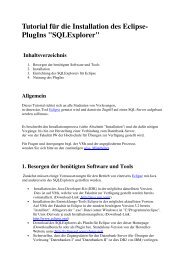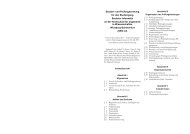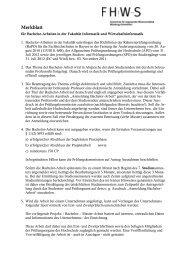FHWS Science Journal - Fakultät Informatik und Wirtschaftsinformatik
FHWS Science Journal - Fakultät Informatik und Wirtschaftsinformatik
FHWS Science Journal - Fakultät Informatik und Wirtschaftsinformatik
Create successful ePaper yourself
Turn your PDF publications into a flip-book with our unique Google optimized e-Paper software.
Mobile Enterprise Application Development - a Cross-Platform Framework<br />
FLORIAN WOLF, KARSTEN HUFFSTADT<br />
Applied Research Center for Mobile Solutions<br />
University of Applied <strong>Science</strong>s Wuerzburg-Schweinfurt<br />
In today’s business mobility of information systems is an important topic. Almost no company can get by these days<br />
without mobile software solutions. At the same time we are going through a convergence of desktop and mobile, web and<br />
native application development. Because of this clear necessarity of mobility and mobile development it is not surprising<br />
that there is a large number of different recommendations for software developer using different technologies. This paper<br />
is going to point out the basic approach of a cross-platform application framework using the example of PhoneGap and -<br />
more importantly - highlights and answers the question if the often promised universal applicability of these frameworks<br />
really apply and a one-off source code is enough to deploy an enterprise application.<br />
Categories and Subject Descriptors: Mobile and Ubiquitous Computing<br />
Additional Key Words and Phrases: Mobile Business, Mobile Applications, Apps, Web Applications, Cross-Platform<br />
Application Framework, PhoneGap<br />
1 INTRODUCTION<br />
It was already acknowledged in the middle of the last decade that mobile ICT-based capabilities<br />
have the potential to increase productivity, efficiency and other important business performance<br />
metrics [Gebauer and Shaw 2004; Basole 2005; Nah et al. 2005; Atkins et al. 2006]. Today<br />
mobility of information systems is an important business topic. Almost no company can get by<br />
these days without mobile software solutions supporting their business.<br />
At the same time we are going through a convergence of desktop and mobile, web and native<br />
application development [Mikkonen et al. 2009]. More and more applications run in web browsers<br />
and do not necessarily require any explicit installation or native source code. Web applications<br />
therefore enable companies to implement software written as a one-off source code in form of the<br />
three components HTML5, JavaScript and CSS rendered in a standard web browser. Using that<br />
approach, developers do no longer need to support various operating systems writing their<br />
applications in native code for iOS, Android, Windows or others. Furthermore web applications<br />
are running without the need to be downloaded and installed separately. In addition to that, they<br />
can be deployed instantly worldwide. All these factors support companies on their way to easily<br />
develop mobile enterprise applications. 7<br />
What remains is the question of how a complex application for enterprises using only<br />
JavaScript, HTML5 and CSS can be supported. With the need of large database handling or<br />
access to the API-functionality of the <strong>und</strong>erlying operating systems such as geolocation or<br />
accelerometer web techniques reach their limits. Because of that, the so called cross-platform<br />
application frameworks were developed which contain native code pieces to interact with the<br />
operating systems and run the web application in a webview [Charland and Leroux 2011].<br />
Author's address: Florian Wolf, Karsten Huffstadt, University of Applied <strong>Science</strong>s Wuerzburg-Schweinfurt, Germany,<br />
http://mobilab.fhws.de.<br />
Permission to make digital or hard copies of part or all of this work for personal or classroom use is granted without fee<br />
provided that copies are not made or distributed for profit or commercial advantage and that copies show this notice on the<br />
first page or initial screen of a display along with the full citation. Copyrights for components of this work owned by others<br />
than <strong>FHWS</strong> must be honored. Abstracting with credit is permitted. To copy otherwise, to republish, to post on servers, to<br />
redistribute to lists, or to use any component of this work in other works requires prior specific permission.<br />
<strong>FHWS</strong> SCIENCE JOURNAL, Vol. 1, No. 1, 2013 33








